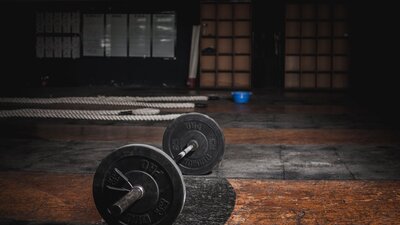Let’s learn the techniques and cues to help you master the standing overhead press. The overhead press is a vertical push movement pattern that has its place in any program. This exercise is potent at building postural stability, shoulder strength, and hypertrophy.
Pressing weight overhead may seem simple, but there are valuable techniques that can carry over into the rest of your training program.
Let’s analyze how implementing these techniques will make your overhead press more confident and improve your whole body through stability and overall body awareness.
Set-Up
Don’t just grab and lift the weight without setting up your entire body. Failing to do so hinders progress and reinforces habits that carry over into other exercises. To set up the lower body and torso, begin with
Feet hip width apart
Soft bend in the knees
Glutes and abdominals squeezed tight to set the pelvis into a neutral position (3)
- Make your waistband parallel to the floor
Ribs down and spine neutral (2)
Correctly setting up the standing overhead press is crucial because maximum stability is needed to safely and effectively push the most weight overhead. Arguably, the most important cue in the overhead press is the co-contraction of the glutes and abdominals.
These muscle groups work together to control the position of the pelvis and spine. With a stable and neutral pelvis position, the kinetic chain can do its job without losing energy and stability from unwanted movement elsewhere.
For setting up the shoulders and arms, begin with
Shoulder blades pulled down and back
Grip width (if using a barbell) that stacks the wrist over the elbow in the bottom position (1)
Elbows pointed slightly forward in the scapular plane (4)
- Imagine you have laser beams pointing out of your elbows and point the lasers slightly in front of you, not sideways
Position the load somewhere between the clavicles and chin
The ultimate purpose of these four techniques is to create maximal stability in the scapulothoracic and glenohumeral joints. The elbows should be pointed slightly forward to not train the movement in the joints' end range of motion. When the elbows are flared out to the sides, it may feel easier and more stable, but this is only because the load is stabilized by the hard end range of the glenohumeral joint instead of all the musculature around the shoulders.
With the entire set-up in place, your entire body should feel like one solid, rigid unit connected by muscle tension.
Ascent and Descent
As the ascent begins, only three joints should articulate. This includes extension of the elbows, flexion of the shoulders, and slight extension through the thoracic spine. The head and neck may also retract and protract to allow the barbell to clear if using a barbell.
During the ascent and descent, focus on maintaining
The glutes and abdominals tight for a neutral pelvis
The wrist over the elbows (1)
The elbows slightly forward
Full elbow extension if mobility allows
A vertical path of the load being lifted
Most mistakes can be avoided simply by following the techniques and cues reviewed.
Outro
From the initial setup to the subsequent descent and ascent, the importance of stability cannot be overstated.
Most overhead press mastery begins before the weight moves, in the form of stability in the hips and shoulders. This stability provides the foundation for the muscles to work on during the lift.
When using these stability techniques, lifters will avoid most mistakes, and the weight will move seamlessly. Optimizing stability throughout the movement makes the difference for maximal strength and joint longevity.
Now that your understanding of the overhead press technique has deepened, overhead press confidently!
Sources
Coratella G, Tornatore G, Longo S, Esposito F, Cè E. Front vs Back and Barbell vs Machine Overhead Press: An Electromyographic Analysis and Implications For Resistance Training. Front Physiol. 2022 Jul 22;13:825880. doi: 10.3389/fphys.2022.825880. PMID: 35936912; PMCID: PMC9354811.
Dicus JR, Holmstrup ME, Shuler KT, Rice TT, Raybuck SD, Siddons CA. Stability of Resistance Training Implement alters EMG Activity during the Overhead Press. Int J Exerc Sci. 2018 Jun 1;11(1):708-716. PMID: 29997723; PMCID: PMC6033506.
Mark R. McKean, Brendan J. Burkett, Overhead shoulder press – In-front of the head or behind the head?, Journal of Sport and Health Science, Volume 4, Issue 3, 2015, Pages 250-257, ISSN 2095-2546,
Reinold MM, Escamilla RF, Wilk KE. Current concepts in the scientific and clinical rationale behind exercises for glenohumeral and scapulothoracic musculature. J Orthop Sports Phys Ther. 2009 Feb;39(2):105-17. doi: 10.2519/jospt.2009.2835. PMID: 19194023.

